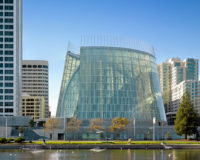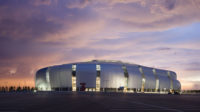On the far West Side of Manhattan, adjacent to Frank Gehry's IAC Building, Ateliers Jean Nouvel's new residential project features a jumble of tilting glass on one facade and simple punch windows framing views of the skyline on the other. We speak with Nouvel's project manager, Francois Leininger, and Marc Simmons of facade consultant Front about both faces of the building.
For decades after World War II, New York City’s private developers were able to attract the affluent classes to perfunctory, low-ceilinged apartments in upended brick shoe boxes. To be sure, in the 1980s some architects embellished new buildings with classical furbelows and pushed ceilings from 8- to 9-foot heights. But rarely was adventurous architecture part of the equation.
The situation began to change at the end of the 20th century: The conversion of light-industrial lofts in SoHo and Tribeca to residential uses starting in the late 1960s whetted the public’s appetite for more spacious apartments with larger windows.
A new breed of developers, lured downtown by rezoning and lower land prices, found that hiring architects with high-design profiles would help sell or rent apartments off the beaten track. Richard Meier’s Perry Street Towers (2002) at the west edge of Greenwich Village, facing the Hudson River, is generally credited with setting a new standard by virtue of the architect’s elegant, sleek, white metal and glass structures with ceilings rising more than 10 feet high.
By the first decade of this century, Herzog & de Meuron, Ateliers Jean Nouvel, Deborah Berke & Partners, Gluckman Mayner Architects, Bernard Tschumi Architects, Smith-Miller + Hawkinson Architects, and Gwathmey Siegel & Associates were invading the turf of the brick-box boys, even if they still occupied the fringes.
In recent years the High Line park on Manhattan’s West Side, with its special district zoning, has prompted a slew of rakish towers by Audrey Matlock Architect, Neil M. Denari Architects, and (again) Nouvel, as well as Shigeru Ban Architects (page 90), and Selldorf Architects (page 94). Down by City Hall, Frank Gehry’s 76-story, stainless steel, faceted high-rise (page 98) shimmers on the skyline.
The new New York apartment house follows Meier’s Perry Street example with large glazed expanses and high ceilings. But the latest crop (e.g., Gehry, Matlock, and Nouvel) shows a tendency to manipulate the skin of the building for an architectonic dimension. True, the special effects may remain on surfaces that wrap conventionally stacked floors with orthogonal plans, but some architects (such as Denari) have altered the form of the building as it rises, or introduced subtle sectional variations in the apartment ceilings (Matlock and Nouvel). Ban and Selldorf overtly manipulate the section to create duplex units. In addition, Ban’s adjustable exterior walls and Selldorf’s apartments with private garages-in-the-air deploy mechanical features to intriguing ends.
No longer is the standard vertical shoe box acceptable for those who can afford to demand more. Space, light, view, and enriched amenities (such as pool, gym, and private entertaining areas) plus architectural variation in plan, section, and elevation seem par for the course. Some of the shapes overreach with au courant contours, some surfaces are contrived, and who knows if movable windows and garages will appeal over a building’s lifetime. Today’s dash may seem to be tomorrow’s gimmickry. But at least the architects and developers are establishing new standards for this historic building type.







Post a comment to this article
Report Abusive Comment